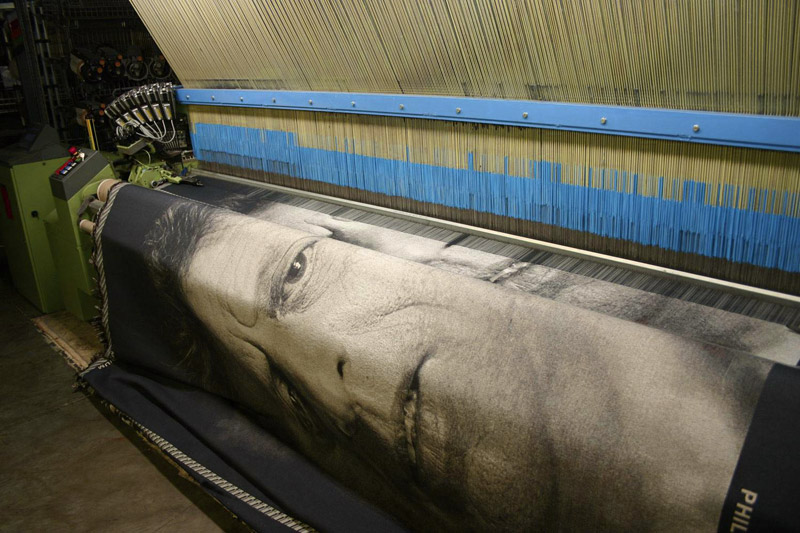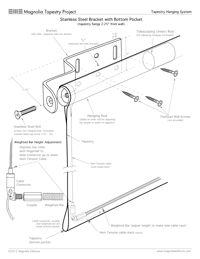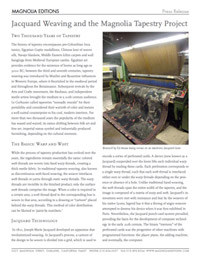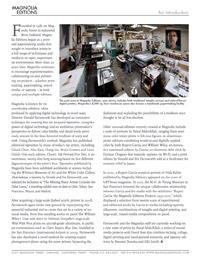
For more information, please see our press releases: Magnolia Tapestries at a Glance is an introduction for those new to the world of fine art tapestries, while Jacquard Weaving provides additional technical and historical detail.
 |
 |
 |
|---|---|---|
| Magnolia Hanging Systems | Jacquard Weaving at Magnolia | About Magnolia |
What is a tapestry?
Tapestry is defined as a thick textile fabric in which colored weft threads are woven into fixed warp threads to form an image. In traditional hand weaving, the weft threads are the horizontal threads or yarns which the weaver or loom weaves back and forth, and the warp threads are the long, fixed vertical threads. With Jacquard weaving, invented in 1804, the warp threads are fed from a spool and run horizontally through the machine. Each warp thread has its own lifter. The weft threads are interwoven across the warp threads, creating the weave.A bit of Tapestry History
For thousands of years, predating classical antiquity, humankind has used the medium of tapestry art to express itself and record its history. Ancient Egyptians and Incas buried their dead in tapestries. Early Greeks and Romans used tapestries in the decoration of affluent homes and important buildings. Archaeologists believe that tapestries covered the walls of the Parthenon. After the collapse of the Roman Empire, tapestry, like so many of the arts and sciences, was re-introduced to Europe by the Moors by way of Spain. During the Middle Ages tapestries were status symbols amongst the aristocracy. Tapestries decorated the stone walls of castles and provided insulation and privacy. Touring kings and nobles transported their tapestry art from castle to castle. In medieval times France, and more specifically Paris, was the center of tapestry production in Western Europe. During the Hundred Years War many important tapestries were lost or burned for their precious metal content. Escaping the chaos, numerous tapestry artists and craftsmen moved to Flanders (present-day Belgium, Northern France and the Netherlands). Flanders became probably the most recognized center of tapestry weaving for three centuries, although important works continued to be produced in France, Italy, Germany and throughout Europe. In the 16th century wars between France and Spain caused Flemish weavers to emigrate to Britain, France and Italy. Medieval weavers used working sketches, from which they freely adapted, to produce their tapestries. By the Renaissance, weavers were more rigidly copying from full-sized, fully-realized drawings or paintings. Tapestries became more copies of paintings rather than independent works of art. Depending on the skill of the craftsperson, these copies could be clumsily or effectively adapted. In 1804, the Jacquard loom was invented by Joseph Marie Jacquard, based on developments by other innovators which built upon the ancient technique of card weaving. Using this method weavers could "program" a pattern of weaving by threading different colors of yarn through holes in cards and then twisting the cards as they wove the weft back and forth to form the pattern. Jacquard's method of weaving involved processing perforated cards, like those later used in player pianos or early computers, which chose the colored threads to be used in the tapestry image. The preparation of the Jacquard card was a difficult and lengthy process, involving several months of work and various color tests. However, once the punch cards were made, the tapestry could then be woven more than once. Apart from a small number of hand-woven tapestries, Jacquard looms are still used today in the production of most tapestries.Tapestries at Magnolia
The unique innovation that Magnolia Editions brings to the time-honored medium of tapestry is a new computerized method that captures minute details of the artist's design and allows the design to be woven directly with no alteration from the weaver. As such, the artist maintains control over the final work and ensures that the result is an authentic expression of the artist's intentions. We also work exclusively with contemporary artists, rather than trying to recreate the works of past masters. Each tapestry we produce is approved and signed by the artist, the creator of the image. We keep the edition size of each image small. In this regard, we feel that our tapestries are produced in a similar spirit of creative vigor and fresh energy that William Morris brought to tapestry in his time. Morris, recognized as the founder of the Arts and Crafts Movement in England, taught himself to weave; he and his colleagues designed, rather than copied, original tapestries, based on medieval styles. The artists of the Arts and Crafts Movement thus created unique works with tapestry that expanded the range of the medium and adapted it to a contemporary context. The custom palettes (colors and shades) employed in the weaving of our tapestries have been created especially for the tapestries by Magnolia Editions, ensuring the greatest range and fidelity to the artist's original design. The tapestries are woven at a small, family-owned mill in Belgium. They are woven of mostly cotton fibers with some viscose, which is a cellulose/cotton product, and some manmade fibers. As with Magnolia Editions' fine art prints, the utmost care is taken in every step of creation and production. We are excited to continue developing a unique technique that blends both old-world weaving processes with the newest digital possibilities. We are pleased with the exactness of detail, the distinctive look, and the authentic mark made by the hand of the artist that appears in these thoroughly contemporary tapestries.Tapestry Care and Maintenance
In most environments your tapestry should require little maintenance. They are very tightly woven, resulting in a sturdy, thick textile with a rather stiff hand. Because your tapestry is mounted on a wall, it is not subject to the same abuse as a carpet or upholstered seating. Once or twice a year it should be lightly vacuumed, both front and back. Place a small piece of cheesecloth over the end of the vacuum hose, or vacuum as you would a piece of fine window drapery. If a tapestry becomes excessively dirty, it can be dry cleaned. Use a dry cleaner who has expertise in cleaning tapestries, as some of the chemicals used in dry cleaning can damage the color of the tapestry and degrade the fibers. A rare or very valuable tapestry should be cleaned by a textile conservator. Your local museum may be able to recommend the name of a reliable conservator. Some tapestry manufacturers recommend gently handwashing tapestries as an alternative to cleaning by an expert. Use suds made from mild soap flakes and warm water. The tapestry should then be rinsed and dried carefully and a steam iron used for pressing. Check the temperature before pressing. Tapestries should never be washed in a machine or dried in a clothes dryer. Avoid hanging your tapestry in direct sunlight to minimize fading and possible fiber weakening over time.show prices
Prices and availability are subject to change without notice.The copyright of all art images belongs to the individual artists and Magnolia Editions, Inc.
©2003-2025 Magnolia Editions, Inc. All rights reserved. contact us
